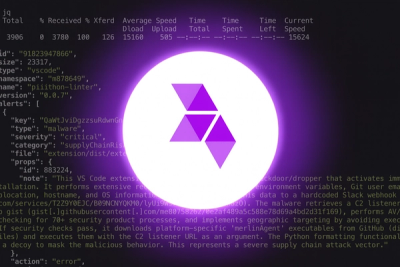
Product
Introducing Webhook Events for Alert Changes
Add real-time Socket webhook events to your workflows to automatically receive software supply chain alert changes in real time.
pull-stream
Advanced tools
Experimental Minimal Pipeable Pull-stream
In classic-streams, streams push data to the next stream in the pipeline. In new-streams, data is pulled out of the source stream, into the destination.
pull-stream is an minimal take on pull streams.
What if implementing a stream was this simple:
var pipeable = require('pull-stream').pipeable
var createStream = pipeable(function (readable) {
return function read (end, cb) {
readable(end, cb)
}
})
Instead of a readable stream, and a writable stream, there is a readable stream,
and a reader stream.
the readable stream is just a function, that may be called many times, and will (asynchronously) callback.
if the user passes in end, then stop returning data.
var i = 100
var randomReadable = function (end, cb) {
if(end) return cb(end)
//only read 100 times
if(i-- < 0) return cb(true)
cb(null, Math.random())
}
A reader, is just a function that calls a readable.
If you get an end stop reading.
var logger = function (readable) {
readable(null, function next(end, data) {
if(end === true) return
if(end) throw err
console.log(data)
readable(end, next)
})
}
These can be connected together by passing the readable to the reader
logger(randomReadable)
Thats cool, but to be useful, we need transformation streams, that do input and output.
Simple!
var map = function (readable, map) {
//return a readable function!
return function (end, cb) {
readable(end, function (end, data) {
cb(end, data != null ? map(data) : null)
})
}
}
join them together!
logger(
map(randomReadable, function (e) {
return Math.round(e * 1000)
}))
That is good -- but it's kinda weird, because we are used to left to right syntax
for streams... ls | grep | wc -l
So, we want to pass in the readable and reader function!
It needs to be that order, so that it reads left to right.
A basic duplex function would look like this:
var i = 100
var multiply = function (readable) {
return function (reader) {
return reader(function (end, cb) {
//insert your own code in here!
readable(end, function (end, data) {
cb(end, Math.round(data * 1000))
})
})
}
}
A stream that is only readable is simpler:
var randomReadable2 = function (reader) {
return reader(function (end, cb) {
cb(end, 'hello!')
})
}
and a "sink" stream, that can only read, is the same as before!
var reader = function (readable) {
readable(null, function (end, data) {
if(end === true) return
if(end) throw end
readable(end, data)
})
}
The reader stream is the same as before!
Now PIPE THEM TOGETHER!
randomReader2 (multiply) (logger)
JUST LIKE THAT!
MIT
FAQs
minimal pull stream
We found that pull-stream demonstrated a not healthy version release cadence and project activity because the last version was released a year ago. It has 4 open source maintainers collaborating on the project.
Did you know?

Socket for GitHub automatically highlights issues in each pull request and monitors the health of all your open source dependencies. Discover the contents of your packages and block harmful activity before you install or update your dependencies.

Product
Add real-time Socket webhook events to your workflows to automatically receive software supply chain alert changes in real time.

Security News
ENISA has become a CVE Program Root, giving the EU a central authority for coordinating vulnerability reporting, disclosure, and cross-border response.

Product
Socket now scans OpenVSX extensions, giving teams early detection of risky behaviors, hidden capabilities, and supply chain threats in developer tools.